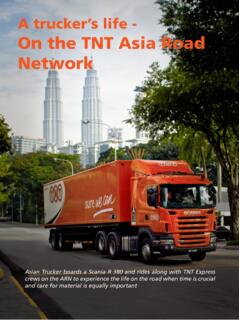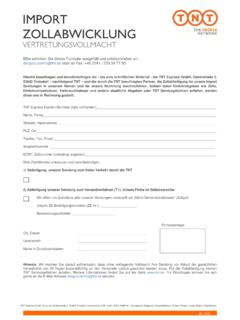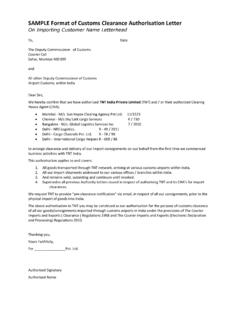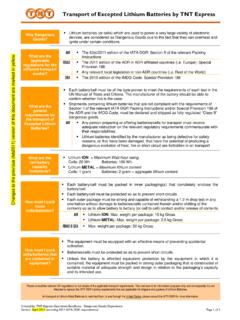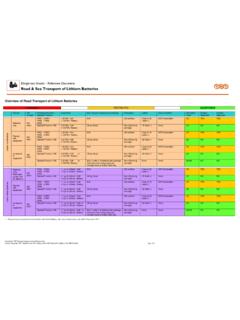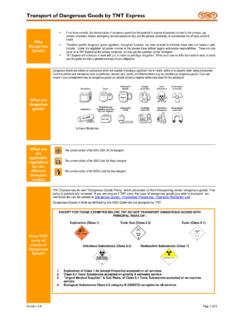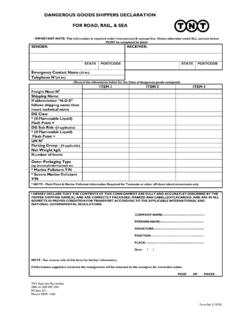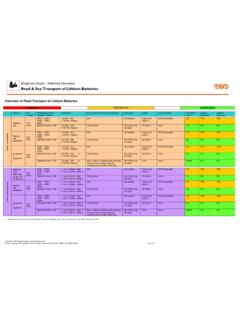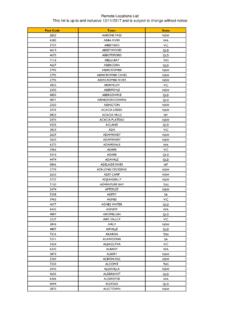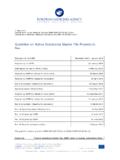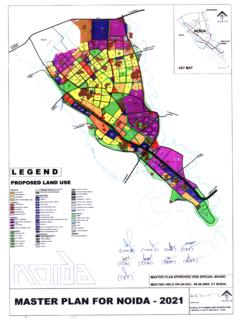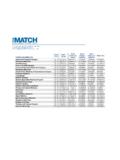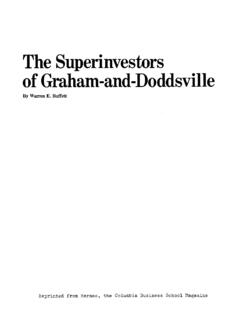Transcription of Air Transport of Section II Lithium Batteries - TNT Express
1 Air Transport of Section II Lithium Batteries Created by: TNT Express Operations Excellence - Dangerous Goods Department Version: January 2019 (based on 60h/2019 IATA Dangerous Goods Regulations) Page 1 of 5 Overview of Air Transport of Section II Lithium Batteries Packed UN number / Packing Instruction Battery capacity / Lithium content per battery Max net weight or quantity Label Documentation Required text on the consignment note DG Option Code Commercial airlines restrictions Lithium Ion Batteries Batteries only UN 3480 PI 965 FORBIDDEN on the TNT Air Network Packed with equipment UN 3481 PI 9662 20 Wh per cell 5 kg net1 Lithium Battery Label None Lithium Ion Batteries in compliance with Section II
2 Of PI 966 LB YES 100 Wh per battery 5 kg net1 Lithium Battery Label None Lithium Ion Batteries in compliance with Section II of PI 966 LB YES Contained in equipment UN 3481 PI 9672 20 Wh per cell or 100 Wh per battery and more than 4 cells or more than 2 Batteries per package 5 kg net Lithium Battery Label None Lithium Ion Batteries in compliance with Section II of PI 967 LB YES 20 Wh per cell 100 Wh per battery Packages containing: Only button cell Batteries contained in equipment (incl. Circuit boards) Max 4 cells or 2 Batteries where there are not more than 2 packages in the consignment or only button-cells installed in equipment.
3 None None None NONE NO Lithium Metal Batteries Batteries only UN 3090 PI 968 FORBIDDEN on the TNT Air Network Packed with equipment UN 3091 PI 969 2 1 gr of Lithium per cell 5 kg net1 Lithium Battery Label None Lithium Metal Batteries in compliance with Section II of PI 969 LB YES 2 gr of Lithium per battery 5 kg net1 Lithium Battery Label None Lithium Metal Batteries in compliance with Section II of PI 969 LB YES Contained in equipment UN 3091 PI 970 2 1 gr of Lithium per cell or 2 gr of llthium per battery and more then 4 cells or more than 2 Batteries per package 5 kg net Lithium Battery Label None Lithium Metal Batteries in compliance with Section II of PI 970 LB YES 1 gr of Lithium per cell 2 gr of Lithium per battery Packages containing: Only button cell Batteries contained in equipment (incl.)
4 Circuit boards) Max 4 cells or 2 Batteries where there are not more than 2 packages in the consignment or only button-cells installed in equipment. None None None NONE NO 1 For Batteries /cells packed with equipment the number of cells or Batteries in each package must not exceed the appropriate number for the equipment s operation plus two spare sets. 2 For the purposes of this packing instruction equipment means the device or apparatus for which the Lithium cells or Batteries will provide electrical power for its operation.
5 Therefore devices like Powerbanks must be classified as Batteries and not as Batteries contained in equipment. Air Transport of Section II Lithium Batteries Created by: TNT Express Operations Excellence - Dangerous Goods Department Version: January 2019 (based on 60h/2019 IATA Dangerous Goods Regulations) Page 2 of 5 Why Dangerous Goods? Lithium Batteries (or cells) which are used to power a very large variety of electronic devices are considered as Dangerous Goods due to the fact that they can overheat and ignite under certain conditions.
6 What are the applicable regulations for the air Transport ? The 60th/2019 edition of the IATA DGR: Section II of the relevant Packing Instructions UN Number Proper Shipping Name Packing Instruction UN3480 Lithium ion Batteries 965 ( Section II) UN3481 Lithium ion Batteries packed with equipment 966 ( Section II) Lithium ion Batteries contained in equipment 967 ( Section II) UN3090 Lithium metal Batteries 968 ( Section II) UN3091 Lithium metal Batteries packed with equipment 969 ( Section II) Lithium metal Batteries contained in equipment 970 ( Section II)
7 What are the general requirements for the Transport of Section II Lithium Batteries ? General requirements for Lithium Batteries as per IATA DGR Cells and Batteries , cells and Batteries contained in equipment, or cells and Batteries packed with equipment, containing Lithium in any form must be assigned to UN 3090, UN 3091, UN 3480 or UN 3481, as appropriate. They may be transported under these entries if they meet the following provisions: (a) each cell or battery is of the type proved to meet the requirements of each test of the UN Manual of Tests and Criteria, Part III, subsection Cells and Batteries manufactured according to a type meeting the requirements of subsection of the UN Manual of Tests and Criteria, Revision 3, Amendment 1 or any subsequent revision and amendment applicable at the date of the type testing may continue to be transported, unless otherwise provided in these Regulations.
8 Cell and battery types only meeting the requirements of the Manual of Tests and Criteria, Revision 3, are no longer valid. However, cells and Batteries manufactured in conformity with such types before 1 July 2003 may continue to be transported if all other applicable requirements are fulfilled. Note: Batteries must be of a design type proved to meet the testing requirements of the Manual of Tests and Criteria, Part III, subsection , irrespective of the whether the cells of which they are composed are of a tested design type.
9 (b) each cell and battery incorporates a safety venting device or is designed to preclude a violent rupture under conditions normally incident to Transport ; (c) each cell and battery is equipped with an effective means of preventing external short circuits; (d) each battery containing cells or series of cells connected in parallel is equipped with effective means as necessary to prevent dangerous reverse current flow ( , diodes, fuses, etc.); (e) cells and Batteries must be manufactured under a quality management program that includes: a description of the organizational structure and responsibilities of personnel with regard to design and product quality; the relevant inspection and test, quality control, quality assurance, and process operation instructions that will be used; process controls that should include relevant activities to prevent and detect internal short circuit failure during manufacture of cells.
10 Quality records, such as inspection reports, test data, calibration data and certificates. Test data must be kept and made available to the appropriate national authority upon request; management reviews to ensure the effective operation of the quality management programme; a process for control of documents and their revision; a means for control of cells or Batteries that are not conforming to the type tested as mentioned in (a) above; training programmes and qualification procedures for relevant personnel; and procedures to ensure that there is no damage to the final product.
